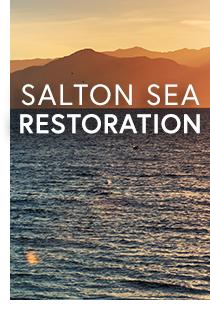 The Salton Sea is located in a closed desert basin in Riverside and Imperial Counties in southern California, south of Indio and north of El Centro. The basin is more than 200 feet below sea level and has no natural outlet. Although lakes have existed in this basin in the past, the current body of water formed in 1905 when a levee break along the Colorado River caused its flows to enter the basin for about 18 months. Since 1905, the Sea has fluctuated in size with varying inflow, and it today has a surface area of about 365 square miles.
The Salton Sea is located in a closed desert basin in Riverside and Imperial Counties in southern California, south of Indio and north of El Centro. The basin is more than 200 feet below sea level and has no natural outlet. Although lakes have existed in this basin in the past, the current body of water formed in 1905 when a levee break along the Colorado River caused its flows to enter the basin for about 18 months. Since 1905, the Sea has fluctuated in size with varying inflow, and it today has a surface area of about 365 square miles.
A balance between inflowing water and evaporation sustains the Sea. Any salts that are dissolved in the inflow are trapped. Salt concentrations in the Sea are currently about 48,000 milligrams per liter (mg/L), or about 30 percent higher than ocean water. Salinity will continue to rise under current conditions, however, under the recently approved Quantification Settlement Agreement inflow to the Sea will be will be significantly reduced. The reduction in inflow will cause the Sea to shrink and cause salinity to rise faster than it would have without a reduction in inflow.
A gradual increase in salinity and its consequences was recognized soon after the Sea was formed. Various salinity control measures were studied as early as the mid-1950s. Since then, many alternatives have been proposed and analyzed. The current effort by the California Resources Agency is the latest attempt to develop a permanent solution to continued degradation of the environmental values of the Sea.
Managing the Sea's natural, agricultural, and municipal water inflows to maximize bird and fish habitat and minimize fine-particle air pollution will allow California to protect regional health, ecological wealth and a stable water supply.
Gov. Jerry Brown's Salton Sea Task Force, created in May 2015, has directed agencies to develop a comprehensive management plan for the Sea that will:
- Meet a short-term goal of 9,000 acres to 12,000 acres of habitat and dust suppression projects; and
- Set a medium-term plan to construct 18,000 acres to 25,000 acres of habitat and dust suppression projects.
These goals were memorialized in 2016 through a 10-year Memorandum of Understanding between the United States Department of Interior and the Natural Resources agency and will be implemented through the Salton Sea Management Program pursuant to the Phase I 10-year plan released in March 2017.
The Natural Resources Agency is committed to a transparent process with clearly defined goals and measurable objectives aligned with available fiscal and hydrological resources. Progress made by the program will be overseen by the State Water Resources Control Board and California Air Resources Board.
In addition, in 2016 the Legislature secured $80.5 million in the state budget, established a road map for long-term goals, as well as directed the Natural Resources Agency to produce a list of shovel-ready mitigation projects.
This year, the California State Legislature has put forward a critical Salton Sea bill package that establishes both a strategy and funding mechanism to mitigate air quality, public health, threats to ecological habitats and communities surrounding the Salton Sea including:
- $80 million from Proposition 1 for Salton Sea Restoration
- $14 million (General Fund) for the Salton Sea Habitat Conservation Fund allocated in the 2017 Budget
- $44 million to implement SB 617 (Hueso and E. Garcia)—Recognizes the state’s role in the Salton Sea and creates Community Action Plans for air quality impacts. AB 617 will bring in $16.7 million in Greenhouse Gas Emission Reduction funds and $27 million in other funds.
- $200 million to from SB 5 (Legislative Parks Bond on the 2018 Ballot)–T he recently passed Parks bond dedicates $200 million to Salton Sea Restoration, including $20 million for the Salton Sea Authority and $10 million for New River projects.
Under the leadership of Gov. Brown, the 2014 California Water Action Plan set forth a vision for California water management that balances statewide water supply security with the protection of public, economic and ecological health. The Salton Sea offers a unique opportunity to preserve these values by leveraging a convergence of support from federal, state, and local stakeholders for a smaller and sustainable sea achieved through the projects outlined in the Phase I: 10-Year Plan.
The Phase I: 10-Year Plan will guide investments at the Salton Sea to protect public health and ecosystem wealth as the Sea recedes and meet goals set forth by the Governor’s Salton Sea Task Force and the Memorandum of Understanding (MOU) executed on August 31, 2016, and amended on January 18, 2017 by the Department of Interior (DOI) and the California Natural Resource Agency (CNRA):




